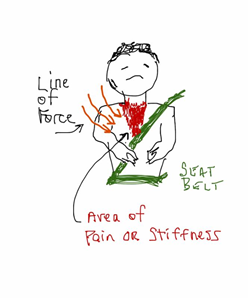Rear-End Collisions Create Major Muscle Havoc–October 23, 2014
Rear-End Pains
No, not pain in the rear-end! A number of our adult clients have significant pains which coincidentally relate to impact patterns matching rear-end auto collisions.
The other thing they have in common is the pains don’t fit any traditional injury patterns and standard therapeutic approaches yield limited improvement. Our clients want to function without weird stiffness and pain in their upper chest! A little insight into why the rear-end collision is so nasty comes from understanding a little bit of physics.
A Quick Physics Lesson
Law of Conservation of Momentum: Objects in motion stay in motion and objects at rest stay at rest unless acted upon by an outside force. Momentum is neither gained nor lost, only transferred.
- Example- When a ball crashes into a foam wall, it slows down. The rule of conservation of momentum states that the energy did not suddenly disappear, but instead was transferred into the foam wall and lost with friction.
- Cars with higher crumple zones are rated safer since the zone absorbs the momentum of another vehicle hitting your car. Vehicles are primarily designed to dissipate force from the front or side minimizing passenger injury. There are no “crumple zones” from the rear.
- The seat belt keeps you from slamming into the steering wheel or dash board. The bad news is, the one unrestrained shoulder takes the full transfer of movement with a concentration to the point of restraint at the mid-chest. This is only an issue with rear-end collisions, not side or front. Ouch!
The Seat Belt—A Concentrator of Force
Safe, but Stiff
The impact and motion of the accident transfers to anything else in the car that moves, which is you! The seatbelt keeps you in place but only from one shoulder. One shoulder stays still and the other moves.
The seat belt, in conjunction with the skeletal system biomechanics, creates a concentrated point of force right at the sternum, commonly called the breastbone. It is a very strange compression and rotational pattern to which the muscles around the chest, shoulder, and neck have a hard time adapting. Hence, the strange stiffness that no imaginable stretch seems to help.
How Do We Help?
The key to restoring the micro-movements in the affected area is to re-create the force distribution field from the rear-end event. Foot position, hand/arm position, driver/passenger seat belt position, angle of impact, etc. They are all important factors since the body retains a kinesthetic imprint from that exact moment in time.
We re-create the force lines to allow the body to bounce back to its pre-accident function restoring the muscle-memory. Our clients are amazed at how freely they move and how open they feel after Bridging® away the accident’s impact. Usually a session or two are all that is required to erase the bad memories.
May you avoid becoming a statistic, but it you do, or know someone who has been rear-ended, we are here to restore you to pre-accident condition.
From infants to adults, we restore your micro-movements quickly returning you to the movement that defines your life!
A Note from Cara
28% of all auto accidents are rear-end collisions. 50% of our adult clients this month have shoulder, chest, or neck limitations in movement that directly link to a prior rear-end auto accident. Crazy!
Often, the amount of auto damage did not correlate to the effects in their body. I find the seatbelt plays a key role in transferring the force of the impact straight to the chest, much like a stiletto heel produces a high impact in a small area.

